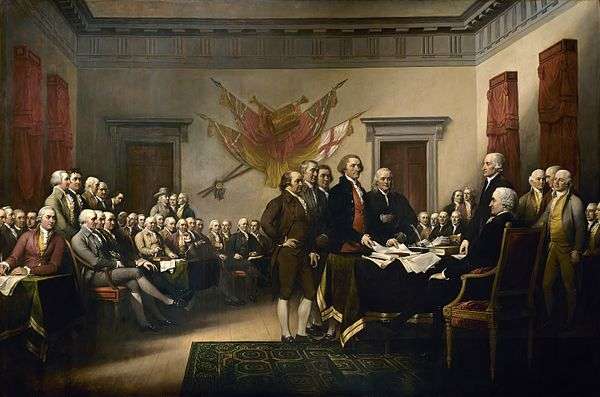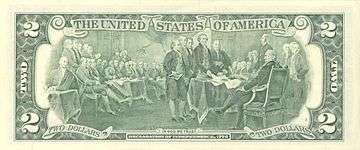Declaration of Independence (Trumbull)
 | |
| Artist | John Trumbull |
|---|---|
| Year |
commissioned 1817; purchased 1819; 1826 placed in the Rotunda |
| Medium | Oil-on-canvas |
| Dimensions | 3.7 m × 5.5 m (12 ft × 18 ft) |
| Location | U.S. Capitol, Washington, D.C., U.S. |
John Trumbull's Declaration of Independence is a 12-by-18-foot (3.7 by 5.5 m) oil-on-canvas painting in the United States Capitol Rotunda that depicts the presentation of the draft of the Declaration of Independence to Congress. It was based on a much smaller version of the same scene, presently held by the Yale University Art Gallery.[1] Trumbull painted many of the figures in the picture from life, and visited Independence Hall to depict the chamber where the Second Continental Congress met. The oil-on-canvas work was commissioned in 1817, purchased in 1819, and placed in the rotunda in 1826.
The painting is sometimes incorrectly described as the signing of the Declaration of Independence. In fact, the painting actually shows the five-man drafting committee presenting their draft of the Declaration to the Congress, an event that took place on June 28, 1776, and not the signing of the document, which took place later.[2]
The painting shows 42 of the 56 signers of the Declaration; Trumbull originally intended to include all 56 signers but was unable to obtain likenesses for all of them. He also depicted several participants in the debate who did not sign the document, including John Dickinson, who declined to sign. Trumbull also had no portrait of Benjamin Harrison V to work with, but his son Benjamin Harrison VI was said to resemble his father, so Trumbull painted him instead. The Declaration was debated and signed over a period of time when membership in Congress changed, so the men in the painting had actually never all been in the same room at the same time.
Thomas Jefferson seems to be stepping on John Adams' foot in the painting, which many thought was supposed to symbolize their relationship as political enemies. However, upon closer examination of the painting, it can be seen that their feet are merely close together. This part of the image was correctly depicted on the two-dollar bill version.
Key to historical figures depicted in the painting

Click anywhere else in the image to go to the image's file page and view a larger version.

The following key to the figures in the painting follows the numbering used by the U.S. government publication "Art of the Capitol" (in the illustration of the key shown in this section) but provides a different (hopefully clearer) description of which figure is where in the painting, so numbers are not entirely in order.
Key to figures (in each group, listed from left to right):
Four men seated on the far left:
- 1. George Wythe
- 2. William Whipple
- 3. Josiah Bartlett
- 5. Thomas Lynch, Jr.
Seated at the table on the left:
Seated together to the right of Harrison and in front of the standing figures:
- 6. Richard Henry Lee
- 7. Samuel Adams
- 8. George Clinton

Five figures standing together on the left:
- 9. William Paca
- 10. Samuel Chase
- 11. Lewis Morris
- 12. William Floyd
- 13. Arthur Middleton
Three seated figures in the back between the two sets of standing figures:
- 14. Thomas Heyward, Jr.
- 15. Charles Carroll
- 16. George Walton
Set of three figures standing together in the back:
- 23. Stephen Hopkins (wearing a hat)
- 24. William Ellery
- 25. George Clymer
Ten figures seated:
- 17. Robert Morris (first on the left at the table)
- 18. Thomas Willing

- 19. Benjamin Rush
- 20. Elbridge Gerry
- 21. Robert Treat Paine
- 22. Abraham Clark
- 26. William Hooper
- 27. Joseph Hewes
- 28. James Wilson
- 29. Francis Hopkinson
Five figures standing in front (the Committee of Five):
- 30. John Adams
- 31. Roger Sherman
- 32. Robert R. Livingston

- 33. Thomas Jefferson
- 34. Benjamin Franklin
Four background figures seated together near the right corner of the room:
- 35. Richard Stockton
- 36. Francis Lewis
- 37. John Witherspoon
- 38. Samuel Huntington
Two figures standing in the right corner of the room:
- 39. William Williams
- 40. Oliver Wolcott
Two foreground figures at the central table:
- 42. Charles Thomson (standing)

- 41. John Hancock (seated)
Three figures standing at right:
- 43. George Read
- 44. John Dickinson

- 45. Edward Rutledge
Two figures seated at far right:
- 46. Thomas McKean
- 47. Philip Livingston
(Note: ![]() - Not a signer of the final Declaration of Independence but depicted in painting. Although Charles Thomson was one of two members listed by name in the earlier Dunlap Broadside as having attested to the Declaration, and many historians believe he had signed the original document that was lost.)
- Not a signer of the final Declaration of Independence but depicted in painting. Although Charles Thomson was one of two members listed by name in the earlier Dunlap Broadside as having attested to the Declaration, and many historians believe he had signed the original document that was lost.)
Unpictured signers
There were 14 signers of the Declaration who did not appear in the painting:
- Matthew Thornton (New Hampshire)
- John Hart (New Jersey)
- John Morton (Pennsylvania)
- James Smith (Pennsylvania)
- George Taylor (Pennsylvania)
- George Ross (Pennsylvania)
- Caesar Rodney (Delaware)
- Thomas Stone (Maryland)
- Thomas Nelson, Jr. (Virginia)
- Francis Lightfoot Lee (Virginia)
- Carter Braxton (Virginia)
- John Penn (North Carolina)
- Button Gwinnett (Georgia)
- Lyman Hall (Georgia)
On U.S. currency and postage stamps

Trumbull's Declaration of Independence signing scene painting has been depicted several times on United States currency and postage stamps. Its first use was on the reverse side of the $100 National Bank Note issued in 1863.[3] The depiction was engraved by Frederick Girsch of the American Bank Note Company.[4] The same steel engraving was used on the 24¢ stamp issued as part of the 1869 pictorial series of definitive U.S. postage stamps.[5]
Trumbull's painting is presently depicted on the reverse of the two-dollar bill. Featured in it are 40 of the 47 figures from Trumbull's painting. Cut out from the scene are: the farthest four figures on the left—George Wythe, William Whipple, Josiah Bartlett, and Thomas Lynch, Jr.; the farthest two figures on the right—Thomas McKean and Philip Livingston; and one of three figures seated in the left rear—George Walton. Additionally, two unknown figures were added: one in between Samuel Chase and Lewis Morris and another between James Wilson and Francis Hopkinson, bringing the total number of figures shown in the presentation scene to 42.
.jpg)

See also
- Scene at the Signing of the Constitution of the United States – a 1940 painting depicting members of the 1787 Constitutional Convention by Howard Chandler Christy.
- Syng inkstand, pictured in the painting
References
- ↑ Yale Art Gallery page on painting.
- ↑ John Hazelton, The Historical Value of Trumbull's - Declaration of Independence, The Pennsylvania Magazine of History and Biography - Volume 31, (Historical Society of Pennsylvania, 1907), 38.
- ↑ "History Timeline". Bureau of Engraving and Printing/Treasury Website.
- ↑ Hessler, Gene (1993). The Engraver's Line – An Encyclopedia of Paper Money & Postage Stamp Art. BNR Press. p. 137. ISBN 0-931960-36-3.
- ↑ Forster, Jeffrey (2012). "The Chronicle's Assistant Section Editor - 1869 Pictorial Issue". U.S. Philatelic Classics Society. Retrieved November 3, 2015.
External links
- Keys to the figures
- Other
- "The Declaration of Independence, July 4, 1776". Yale University Art Gallery.
- A web page with some information on the painting
- Architect of the Capitol Web page on the painting
